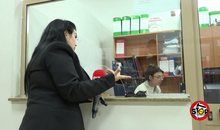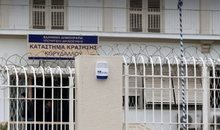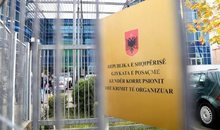
 Flash News
Flash News
Artan Lame passes away at the age of 58
Murder of Ermir Dedja, two people are wanted, the perpetrators' vehicle was secured
Study: Dam construction brings serious ecological consequences on the source of the Vjosa River
Germany extends the stay of its troops in Kosovo
Greek police raid Albanian cells in Korydhalos, discover arsenal and drugs at "prison mafia boss"

The GAP Institute has published the report “Emigration and the Labor Market in Kosovo: The Untapped Potential of the Inactive Labor Force.” According to this report, official data shows that by 2023, 359 thousand people have left Kosovo.
The GAP Institute on Wednesday published the new report "Emigration and the Labor Market in Kosovo: The Untapped Potential of the Inactive Labor Force", which sheds light on the major challenges facing the labor market in the country.
According to the report, by 2023, around 359 thousand people had left Kosovo to various countries around the world.
"By 2023, according to official data, the number of people who have left Kosovo for various countries around the world has reached 359 thousand people, which represents about 22.6% of the country's population, while the number of returned Kosovar citizens and foreigners living in Kosovo is about 99 thousand people. A portion of the people who are emigrating from Kosovo are from the active labor force, which is affecting the increase in demand in the country for local and foreign workers."
This negative migration balance has significantly impacted the labor shortage in the local market.
"According to the data, out of about 1.1 million people of working age, only 43% are economically active, while 57% are inactive. Of the latter, 66% are women and 34% are men, highlighting the low participation of women in the labor market."
The report recommends several measures to address this situation, including training tailored to real labor market demands, policies that help women enter the labor market, professional reorientation for young people not engaged in education, employment or training (NEET), close cooperation between education and the private sector for better professional preparation, incentives for employers who hire people who have been out of the labor market for a long time, support for innovative technologies, and support for the advancement of skills in the field of clean energy.
The GAP Institute has emphasized that increasing the market inclusion of people who are currently inactive is the most sustainable solution to address the labor shortage in Kosovo.
"This requires joint commitment from public institutions, the private sector and civil society to create a favorable environment for employment and economic development."
In 2024, the Ministry of Internal Affairs (MIA) in Kosovo issued a total of 8,293 residence permits to foreign citizens, of which 3,974 were for employment reasons. Most of these immigrants originate from countries in the region such as Albania, Serbia, North Macedonia and countries outside the region such as Turkey, Bangladesh, the Philippines and other Asian countries. However, over half of these permits issued are a continuation of previous years. As a result, the balance of emigration remains much higher than immigration and foreign workers do not cover the shortage created in the labor market.
The most sustainable solution to address the labor shortage in Kosovo is to increase the market inclusion of people of working age who are currently not active in the market (who are not working and not looking for work).
Kosovo has the highest rate of inactivity in the Western Balkans: out of around 1.1 million people of working age, only 461 thousand people (43%) are economically active, while 613 thousand people (57%) are inactive. Of the inactive people, 66% are women and 34% are men, which means that the particularly low participation of women in the labor market remains a serious challenge. Kosovo ranks first in Europe and fifth worldwide for the lowest participation of women in the labor market. Also, 78 thousand young people (30%) are not engaged in education, employment or training (NEET), a percentage much higher than the EU average (9.9%) and the highest in the region.
The sectors most affected by the labor shortage are construction, wholesale and retail trade, gastronomy and hotels, and manufacturing, from which the tendency to emigrate is also higher. Most job positions in these sectors do not require high qualifications, but involve tasks that can be learned within a short period of time, suggesting that the inactive local workforce could meet these requirements.
The report offers several recommendations and measures aimed at improving the inclusion of the inactive workforce in the labor market, such as: training to advance knowledge and facilitate inclusion in the labor market; support for increasing the participation of women and youth in the labor market; strengthening the role of the Employment Agency; as well as support for innovative technologies and the advancement of skills in the field of clean energy./ Monitor
Latest news


"Toyota Yaris", GJKKO sentences lawyer Radovan Çela to 4 years in prison
2025-05-22 10:56:47
Artan Lame passes away at the age of 58
2025-05-22 10:45:00


Anti-drug mega-operation, checks at the Port of Vlora
2025-05-22 10:13:54



European Union's top diplomat Kallas visits Serbia and Kosovo
2025-05-22 09:36:58
Capital investments at lowest level since 2010
2025-05-22 09:27:12
Two Israeli Embassy staff members killed in Washington
2025-05-22 09:12:46
Pyjet tropikale pësuan shkatërrim rekord në vitin 2024
2025-05-22 09:04:20
Foreign exchange, May 22, 2025
2025-05-22 09:00:12

Accident on the Durrës-Tirana highway, vehicle overturns on the road
2025-05-22 08:31:24

Horoscope, what do the stars have in store for you today?
2025-05-22 08:08:02
Showers, what are the temperatures expected to be like during the day?
2025-05-22 07:54:04
Morning Post/ In 2 lines: What mattered yesterday in Albania
2025-05-22 07:41:33


Germany extends the stay of its troops in Kosovo
2025-05-21 22:19:22
Journalist: Xhevdet Troplini alongside a politician
2025-05-21 22:00:07
Amnesty International: Camps in Albania, a reflection of an inhumane system
2025-05-21 21:49:09
This is the first Albanian justice collaborator
2025-05-21 21:39:45
Bitcoin breaks historical record: Reaches $109,302
2025-05-21 21:36:06
Raped by colleague at the civil registry office, victim fired from job
2025-05-21 21:08:47
Hyn në fuqi vendimi i BSH/ Kredia për blerje banese kufizohet nga 1 korriku
2025-05-21 21:04:37
“Nga dhuna e burrit humba fëmijën”, nëna e dy të miturve kërkon drejtësi
2025-05-21 20:50:23
The government extends the stay of Ukrainians in Albania
2025-05-21 20:45:04
Social networks: Friend or foe of our personal relationships?
2025-05-21 20:22:33







The famous soprano of TKOB passes away prematurely
2025-05-21 18:27:50

Donald Trump's son says he might one day run for US president
2025-05-21 17:53:20

Israel's Eurovision result raises questions about voting
2025-05-21 17:23:29
Florence, two Albanians arrested with 23 kg of cocaine
2025-05-21 17:03:20
Sailing suspended due to bad weather in Vlora
2025-05-21 16:58:12
The abolition of the vote as a triumph of banality
2025-05-21 16:41:56


Operation "Bridge"/ Ekil Nderjaku is sentenced to "prison arrest"
2025-05-21 16:08:32

Who needs more physical exercise: Women or men?
2025-05-21 15:43:25
Former Ukrainian politician shot dead near a school in Madrid
2025-05-21 15:32:18
Operation "Bridge"/ Ekil Nderjaku is given another security measure in his cell
2025-05-21 15:22:37
Chocolate will reach high prices! Cocoa production in serious crisis
2025-05-21 15:11:34




"Grandma", "beast", the nicknames used by Albanian and Italian traffickers
2025-05-21 14:26:47
Pope Leo asks Israel to allow humanitarian aid into Gaza
2025-05-21 14:18:42

Document/ How did Nuredin Dumani hit Xhevdet Troplini's group of traffickers?
2025-05-21 14:05:45

Megaoperation/ Group based in Durres, names of Albanian traffickers revealed
2025-05-21 13:42:44
Former politician shot dead outside his children's school
2025-05-21 13:39:27
A ka BE-ja ende mjete efektive për t'i shkaktuar dhimbje Rusisë?
2025-05-21 13:26:33
Berisha: We will never accept such choices, no one can force us to accept them
2025-05-21 13:25:29




A 24-year-old man was found dead in Lake Farka.
2025-05-21 12:37:34

The abolition of the vote as a triumph of banality
2025-05-21 12:18:53

The only name for May 11th is: Electoral Terrorism
2025-05-21 12:06:25


Letter-order from Belgium, SPAK checks 4 premises, 33-year-old arrested in Berat
2025-05-21 11:37:31
Hajj 2025/ Everything you need to know about the annual pilgrimage to Mecca
2025-05-21 11:28:43

The appeal of the GJKKO leaves the head of the Road, Roven Zeka, in prison
2025-05-21 11:02:16

Kuçova! 66-year-old man sexually harasses 17-year-old girl
2025-05-21 10:41:40

Mental disorders and obesity threaten adolescents
2025-05-21 10:22:04


19 killed in Gaza by Israeli attacks, most of them children
2025-05-21 09:50:03
Tabaku: SP seeks to usurp independent institutions
2025-05-21 09:40:19



Is the Socialist Party's supermajority a danger to democracy?
2025-05-21 09:01:54


Video/ Explosives found at Veliera in Durrës, near Vangjush Dako's apartment
2025-05-21 08:32:15
The lack of flights at Vlora airport jeopardizes tourism guarantee contracts
2025-05-21 08:22:54
